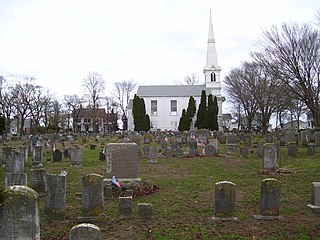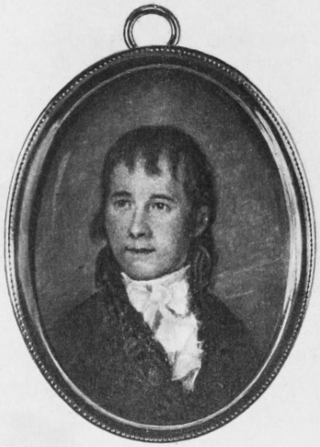
John Alden was a crew member on the historic 1620 voyage of the Mayflower which brought the English settlers commonly known as Pilgrims to Plymouth Colony in Massachusetts. He was hired in Southampton, England as the ship's cooper, responsible for maintaining the ship's barrels. He was a member of the ship's crew and not a settler, yet he decided to remain in Plymouth Colony when the Mayflower returned to England. He was a signatory to the Mayflower Compact.

Myles Standish was an English military officer and colonist. He was hired as military adviser for Plymouth Colony in present-day Massachusetts, United States by the Pilgrims. Standish accompanied the Pilgrims on the ship Mayflower and played a leading role in the administration and defense of Plymouth Colony from its foundation in 1620. On February 17, 1621, the Plymouth Colony militia elected him as its first commander and continued to re-elect him to that position for the remainder of his life. Standish served at various times as an agent of Plymouth Colony on a return trip to England, as assistant governor of the colony, and as its treasurer.

Little Compton is a coastal town in Newport County, Rhode Island, bounded on the south by the Atlantic Ocean, on the west by the Sakonnet River, on the north by the town of Tiverton, and on the east by the town of Westport, Massachusetts. The population was 3,616 at the 2020 census.

Duxbury is a historic seaside town in Plymouth County, Massachusetts, United States. A suburb located on the South Shore approximately 35 miles (56 km) to the southeast of Boston, the population was 16,090 at the 2020 census.

The Courtship of Miles Standish is an 1858 narrative poem by American poet Henry Wadsworth Longfellow about the early days of Plymouth Colony, the colonial settlement established in America by the Mayflower Pilgrims.

Priscilla Alden was a noted member of Massachusetts's Plymouth Colony of Pilgrims and the wife of fellow colonist John Alden. They married in 1621 in Plymouth.

The William Cullen Bryant Homestead is the boyhood home and later summer residence of William Cullen Bryant (1794–1878), one of America's foremost poets and newspaper editors. The 155-acre (63 ha) estate is located at 205 Bryant Road in Cummington, Massachusetts, overlooks the Westfield River Valley and is currently operated by the non-profit Trustees of Reservations. It is open to the public on weekends in summer and early fall for tours with an admission fee.

The Cushnoc Archeological Site, also known as Cushnoc or Koussinoc or Coussinoc, is an archaeological site in Augusta, Maine that was the location of a 17th-century trading post operated by English colonists from Plymouth Colony in present-day Massachusetts. The trading post was built in 1628 and lies on the Kennebec River. The English primarily traded with bands of the Abenaki nation.

The Myles Standish Burial Ground in Duxbury, Massachusetts is, according to the American Cemetery Association, the oldest maintained cemetery in the United States.

Myles Standish Monument State Reservation is a state-owned historic preserve and public recreation area in Duxbury, Massachusetts. The focus of the state park is a 116-foot granite shaft topped by a statue of Captain Myles Standish. Standish was military leader of Plymouth Colony. The park is managed by the Massachusetts Department of Conservation and Recreation.
Reverend Ichabod Wiswall (1637–1700) was the third pastor of the church in Duxbury, Plymouth Colony, British America. Though he is thought to have given the first known funeral sermon in British America at the burial of Capt. Jonathan Alden in 1697, American funeral sermons predate this event by several decades.
Thomas Wiswall (1601–1683) was an early settler of British America, a prominent early citizen of the Massachusetts Bay Colony, and a key figure in the founding of Cambridge Village, now known as the city of Newton, Massachusetts.

Alden Bradford was an American politician, clergyman and author who served as the 5th Massachusetts Secretary of the Commonwealth.
Philip Delano was a passenger on the Fortune and an early citizen of Plymouth Colony. He is best known as the progenitor of the Delano family in the Americas.
Roland Wells Robbins (1908–1987) was an American archaeologist, author, and historian who is known for discovering the site of Henry David Thoreau's house at Walden Pond. His other discoveries include the Saugus Iron Works and the John and Priscilla Alden Family Sites.

Capt. Jonathan Alden Sr., the son of Mayflower immigrants, was a military officer and farm owner in Plymouth Colony. The home he built in the late 1600s is now a National Historic Landmark in Duxbury, Massachusetts.

The Bluefish River is a stream in Duxbury, Massachusetts ending in a tidal river estuary that was the center of an active shipbuilding industry during the early 19th century. Its source is a set of small ponds located near the intersection of Partridge Road and Washington Street, about one-third of a mile from Hall's Corner in Duxbury. The river is fed by Hounds Ditch Brook which empties into the Bluefish at the tidal estuary. The river contains Duxbury’s second anadromous fish run, with a privately-owned fish ladder south of Harrison Street. A large portion of the northern shore of the Bluefish River estuary is occupied by the Capt. David Cushman Preserve operated by the Wildlands Trust which contains walking trails with views of the estuary. Near its mouth, the river passes under the stone Bluefish River Bridge, a local landmark and part of the Old Shipbuilders Historic District. The river discharges into Duxbury Bay between Long Point and Bumpus Park.

Myles Standish Park is a municipal park in the town of Duxbury, Massachusetts. It consists of a 1-acre (0.40 ha) parcel of land encompassing the former site of the home of the early Pilgrim settler Myles Standish. The park was established in 1929 after the land was given to the town by the Myles Standish Monument Association. It was listed on the National Register of Historic Places in 2021.






















